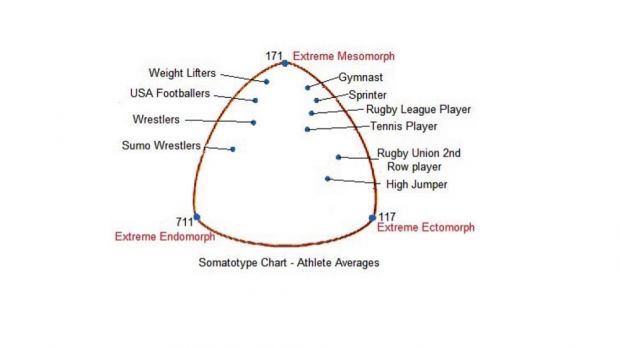Ectomorph, Endomorph And Mesomorph: How To Train For Your Body Type
Train for the right body shape – whether you’re ectomorph, endomorph or mesomorph – and you can outsmart your genes

We all know someone who merely has to look at a dumbbell to start putting on muscle, while others find it almost impossible to add significant bulk but equally don’t tend to add much fat – even when their lifestyle and diet don’t seem all that healthy.
While humans rarely fit exactly into one body type category, your type can still play a significant role in how easy you find it to put on and maintain muscle, or indeed lose fat. Yet it’s fair to say most people probably don’t consider it much when mapping out a training plan.
There are three broad body types into which we all fall to some extent: ectomorph, endomorph and mesomorph. Ectomorphs are naturally lean and rangy, and struggle to add mass in the gym, but they don’t add fat quickly when they’re not training much. Endomorphs are the opposite. They add muscle easily, but they also have a natural pear shape and higher levels of body fat, and often find it harder to avoid unwanted weight gain.
Somewhere in the middle of those two types are mesomorphs, who have an athletic build, a high metabolism, and add muscle easily. Going by a set of totally arbitrary aesthetic standards mesomorphs seem to be the big winners when it comes to genetics, but it’s worth reiterating that very few people fall perfectly into one of these categories – almost all of us are a mix of a couple of them.
Below you’ll find all the information you need to identify which body type (or types) you are, plus advice on what that means for your training and diet plans.
Falling Between Categories
Although there are three clear body types, it’s important to be aware that these aren’t set in stone.
“The three body types exist but probably never in their pure form,” says Professor Lars McNaughton from Edge Hill University.
Sign up for workout ideas, training advice, reviews of the latest gear and more.
“We all have some aspects of endomorphy, mesomorphy and ectomorphy.”
There’s even a system for rating what mix of types you are, the Heath-Carter method, where you are given a score between one and seven for each body type (you can go outside this range, but it’s generally within those numbers).
“You are scored in an order with endomorphy first, then mesomorph, then ectomorphy,” says McNaughton.
“So a 1-7-5 would be a mesoectomorph – a tall muscular person with little fat.”
Under the Heath-Carter system, an extreme mesomorph would be rated 1-7-1, an extreme endomorph 7-1-1 and an extreme ectomorph 1-1-7. Almost everyone is a mix, though, so it’s case of identifying your own body type and how it fits into each category.
You could be a mix of mesomorph and endomorph where you gain muscle quickly but also put on weight easily if you relax your diet. Or the dream combo: a muscular mesomorph who can strip fat rapidly from just a couple of HIIT workouts. If that’s you, try not to rub it in everyone’s face.
The chart below shows where athletes from various sports fit in the Heath-Carter system. It’s a good starting point for identifying your own body type.

How To Train For Your Body Type
While individuals who are exclusively one body type are extremely rare, you probably have some idea of where you fall within the Heath-Carter system. And while there’s no one true fitness goal everyone should be striving towards, some goals will be harder to achieve for bodies that lean towards certain types. Here’s what you may need to take into account if you’re predominantly one body type.
Ectomorphs
Naturally skinny types will find it harder to add muscle, so if that’s you, you’ll need to follow the fundamentals of building muscle to the letter.
“Ectomorphs need to increase their calorie intake, trying to get it from healthier foods, with an emphasis on protein in the diet,” says exercise physiologist Tom Cowan. “If you’re an ectomorph you should consume protein regularly – every three to four hours. Your intake either side of a workout is particularly important, so maybe a protein shake before strength training and then one within an hour or so after. There is also research to suggest that consuming protein before bed can help to increase muscle protein synthesis rates overnight, and limit the duration of the fasting period when you are asleep.
“Combine that with hypertrophy strength training – eight to 12 reps of an exercise, multiple sets – to promote muscle growth.”
Endomorphs
“For endomorphs the focus should be on losing fat,” says Cowan. “You need to be in a negative calorie balance. You can reduce their calories in or increase the calories out, or ideally a mixture of both.”
When it comes to diet, a good starting point is less fat and more protein, with the latter helping to build and maintain muscle mass.
“You should reduce your fat intake, because fat contains more calories per gram than carbohydrates or protein,” says Cowan, “and slightly increase how many of your calories are coming from protein.”
On the exercise front a broad approach is key for endomorphs to lose weight and keep it off.
“You definitely want cardio in there – steady-state cardiovascular exercise at lower to moderate intensity will burn fat,” says Cowan. “Once you’ve built up a good level of cardiovascular fitness, add in some HIIT or circuit training. That will get the heart rate up and increase the rate of calorie expenditure per minute, compared with steady-state training. HIIT also increases the metabolic rate, not just during the session but for several hours after the session.
“Endomorphs are more likely to be overweight. If you are, you will need to think carefully about the type of cardio you do. Weight-bearing exercise can create joint issues, so running all the time might take a toll on your knees, hips and ankles. Before you’ve lost some weight, maybe look at non-weight bearing exercises like swimming or cycling.
“Strength training is also really important. Muscle mass is a big indicator of metabolic rate. The more muscle you have the quicker your metabolic rate will be, so you burn more calories at rest. This will help tip the seesaw of calories in versus calories out in your favour. Also muscle is key because when you have lost the weight, your metabolism is quicker because you have more muscle mass, so there’s less chance of the weight going back on again.
“Finally, think about NEAT – Non Exercise Activity Thermogenesis. Which is just saying, let’s try to get endomorphs as active as possible in general. Try to reduce sedentary behaviours.” In layman’s terms: Sit less, move more.
See related
- The Benefits Of A High-Protein Diet
- What You Need To Know About Your Metabolism For Weight Loss
- Running For Weight Loss: An Expert Explains All
Mesomorphs
Mesomorphs might have won the genetic lottery by having a naturally muscular build and less of a tendency to store fat than endomorphs, but there’s a danger of complacency.
"For mesomorphs it’s more about maintenance of that muscle mass,” says Cowan. “You will also lose muscle mass with age from your 30s. The way to try and reduce that loss is to keep going with strength training and keep enough protein in your diet.”
What mesomorphs should do with their training and diet will often depend on their overall fitness and sporting goals.
“If you’re a mesomorph with a sport-specific goal things might change a little bit,” says Cowan, “and if you want to get bigger then you’re going to have to think about the ectomorph approach – gain mass by increasing calorie and protein intake. You might step up their strength training too, with more hypertrophy range training.
“If you’re a mesomorph who just wants to maintain you might have a more balanced diet without so much protein, and you might not have to do such frequent strength training – maybe just twice a week rather than three, four or five times.”

Nick Harris-Fry is a journalist who has been covering health and fitness since 2015. Nick is an avid runner, covering 70-110km a week, which gives him ample opportunity to test a wide range of running shoes and running gear. He is also the chief tester for fitness trackers and running watches, treadmills and exercise bikes, and workout headphones.
